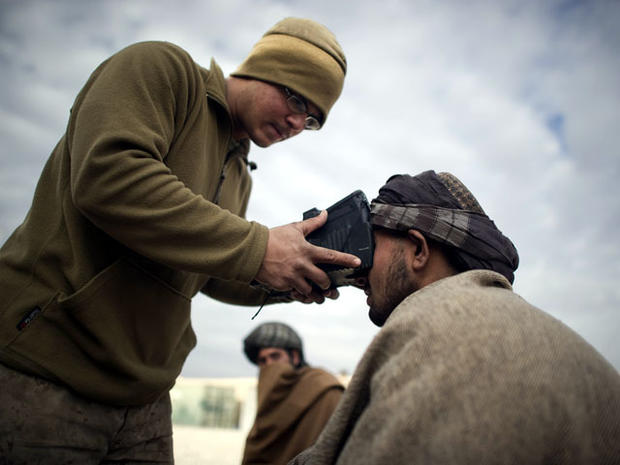iPhones Help U.S. Troops Target Afghan Attackers
This post, written by Harry Sanna, originally appeared on GlobalPost.
PECH VALLEY, Afghanistan - The rocket landed hard and without warning, disrupting an otherwise peaceful morning at Forward Operating Base Blessing in Afghanistan's Pech Valley. The 82 millimeter Russian-made round detonated on impact, shattering concrete from the base of a nearby barricade and peppering nearby sleeping quarters with searing shrapnel.
Special Section: Afghanistan
Arriving on the Battle Field: iPhones, Androids
In the frantic minutes following, the base's immediate response teams got to work. A medic unit arrived, stretcher in hand, while an ordnance specialist analyzed the blast. As the base's artillery began its bombardment of the area where the rocket was launched, one soldier stood on scene equipped with nothing more than his Apple iPhone.
Capt. Jonathan Springer, a 31-year-old artillery specialist with the 101st Airborne and self-described Apple fanatic, is about to launch Tactical Nav, an app for Apple devices that, among other functions, assists soldiers in mapping, plotting and photographing waypoints on a battleground and conveying coordinates to supporting units.
"I've been an iPhone user for quite a while and I'm obviously a Mac guy," Springer said. "I'm a heavy pusher of the iPhone because of what it can do and I see the benefits, not only at home, but here in combat."
Tactical Nav incorporates a compass, camera and a gridded map reference system to accurately pinpoint specific locations down to a few feet and relay that information to other users linked in.
Practical military applications for such a technology, Springer said, range from pinpointing, and locking on to, enemy positions for artillery teams miles away to logging locations of improvised explosive devices along a road to calling in a medevac helicopter for injured soldiers.
"My wish is to provide a soldier with a very inexpensive, accurate tool to help them in combat or back in the states if they're hunters or outdoor enthusiasts," Springer explained. "I've got to think what do my soldiers need to go into battle? What do my soldiers need that could save their lives? So that's what I'm thinking about right now."
Working with a software coder and design company back in the states, Springer has devoted tens of thousands of dollars and a considerable amount of his spare time during deployment on getting his vision up and running.
"I've been blessed to come up with this idea that's taken on a mind of its own in expanding and I'm over here fighting in Afghanistan, being able to test it and get real-world user feedback from soldiers."
Springer, who is now on his third deployment, prides himself on the app's attention to detail. Tactical Nav users are able to switch between degrees of latitude and longitude as well as angular mils, a unit of measurement used by artillery teams the world over. The phone can also switch to red-light mode, a useful addition when soldiers need to conceal sources of light in the field.
While sticking to its "designed by soldiers for soldiers" ethos, Springer was quick to point out the app's civilian uses. The app, he said, could be used by anyone from hunters tracking a buck through the wilderness to his mother navigating her way around a department store.
Tactical Nav would be the latest addition to a growing market of "killer apps" applicable for Apple users on the battlefield. Bulletflight and iSnipe have been competing for a year now over Apple's marksmanship enthusiasts with a ballistics calculator app that predicts bullet trajectory by analyzing fluctuations in atmospheric conditions, wind conditions and altitude.
Other apps in the running include an information collector for counter-insurgency operations and military-specific networking applications.
Early last year, media outlets reported that members of the U.S. Army's technology branch met with representatives of Apple to discuss potential operational uses for the versatile and lightweight products the company manufactures.
With the advent of such publicly accessible technologies, a concern looms over apps like Tactical Nav falling into the wrong hands.
"The last thing I want to do is create something that is going to give the enemy an advantage," Springer said. "If it gets to the point where I've got Taliban rocking an iPhone and my software to use against us then that's a problem."
Although the image of a bearded, black-turbaned Taliban fighter clutching an RPG-7 in one hand and an iPhone in the other does seem a stretch, insurgents in the area have proved highly adaptable in the past. According to sources in the military, militants fighting coalition forces in Afghanistan are sporadically sighted with satellite phones and navigational systems.
Smart phones and similar gadgets are projected to have an upward presence on the battlefield over the coming years as bulkier "green box" technologies traditionally used by mainstream military become increasingly cumbersome in comparison to smaller devices on the market.
In the meantime, Springer hopes to launch Tactical Nav for the iPhone and iPod Touch on the Apple App Store in the first week of February, and depending on its success, package the app for the iPad shortly after.
